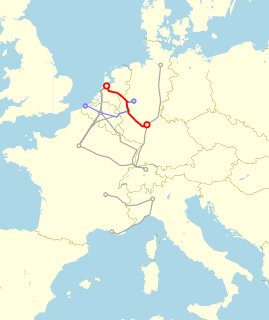
The trainsets of Class VT 11.5 were diesel multiple units built by Deutsche Bundesbahn (DB) in 1957 and used for Trans Europ Express (TEE) services. Perceived as flagships of the DB rolling stock, they carried first-class seating only. When the UIC numbering scheme became effective on 1 January 1968, the power heads of the trainsets were renamed to Class 601 whilst the middle cars became Class 901 according to the DB locomotive classification. They were used for TEE service from 1957 until 1972 and thereafter on German InterCity services.

The DB Class 403 was a series of three electric multiple units commissioned by the Deutsche Bundesbahn in the 1970s, an early predecessor of the Intercity-Express as a high-speed train. The units were mainly used for InterCity services and again by the Lufthansa airline in the 1980s. Due to the distinctive design of its front section, the unit was nicknamed the "Donald Duck". They were designed for operational speeds of up to 220 km/h, a speed which was also attained in extensive test drives, but they were limited to 200 km/h in regular DB service.

The Vogelfluglinie (German) or Fugleflugtslinjen (Danish) is a transport corridor between Copenhagen, Denmark, and Hamburg, Germany.

The Hamburg–Lübeck railway is one of the most important mainline railways of the German states of Schleswig-Holstein and Hamburg. It connects the two Hanseatic cities of Hamburg and Lübeck, and is part of the line to Denmark. The line was opened in 1865.

Intercity is the second-highest train classification in Germany, after the ICE. Intercity services are loco-hauled express train services, usually over long-distances. There are Intercity routes throughout Germany, and routes generally operate with a two-hour frequency, with multiple routes giving a more frequent service on core routes. Intercity services are operated by the DB Fernverkehr sector of Deutsche Bahn.

The Lübeck–Puttgarden railway is part of the international Vogelfluglinie between Germany and Denmark and connects Lübeck with Puttgarden on the Baltic Sea island of Fehmarn in the German state of Schleswig-Holstein.

Puttgarden station is a major ferry terminal on the Vogelfluglinie on the island of Fehmarn in the German state of Schleswig-Holstein. It lies between the town of Puttgarden and Marienleuchte.

The Helvetia was an express train that, for most of its existence, linked Hamburg-Altona station in Hamburg, Germany, with Zürich HB in Zurich, Switzerland. Introduced in 1952, it was operated by the Deutsche Bundesbahn / Deutsche Bahn (DB) and the Swiss Federal Railways (SBB-CFF-FFS). The train's name, Helvetia, is the Latin word for "Switzerland".

The Blauer Enzian is a named express train service that currently runs between Frankfurt in Germany and Klagenfurt in Austria. Introduced in 1951, it originally ran via the German North–South railway line between Hamburg and Munich. Labelled as an international Trans Europ Express (TEE) train, it also linked with Zell am See and Klagenfurt in Austria from 1969. Trains were operated by the Deutsche Bundesbahn (DB) and its Deutsche Bahn successor, from 1970 also by the Austrian Federal Railways (ÖBB).
The Diamant was an express train operated by the Deutsche Bundesbahn (DB), using different routes over the years. The name Diamant, Flemish for diamond, refers to the city of Antwerp, which is the European centre of diamond trade and has a diamond district. The initial service started in 1962 as a first-class-only FernTriebwagen linking the West-German capital Bonn with Antwerp, using a class DB Class VT 08 diesel multiple unit (DMU).

The Rhein–Main was an express train that linked Frankfurt am Main with Dortmund in Germany and later with Amsterdam in the Netherlands. The train was named after the two rivers, the Rhine and the Main, that join west of Frankfurt. For most of its life, it was a Trans Europ Express (TEE).

The Paris–Ruhr was an express train that linked Paris in France, with Dortmund in Germany. The train was named after its two termini, Paris in the west and the Ruhr district in the east. For most of its life, it was a Trans Europ Express (TEE).

The Rembrandt was an express train that linked Amsterdam in the Netherlands, with Munich in Germany and later Chur in Switzerland. The train was named after the renowned Dutch painter Rembrandt. For its first 16 years it was a first-class-only Trans Europ Express, becoming a two-class InterCity in 1983 and finally a EuroCity in 1987.

The Parsifal was an express train that linked Paris with Dortmund in Germany and later Cologne. The train was named after Wagner's opera inspired by the legendary knight Percival.
The Bacchus was an express train in Germany, initially linking Dortmund and Munich. The train was named after the Roman God of wine, although for most of its existence it linked two cities famous for producing beer.
The Friedrich Schiller was an express train in Germany, initially linking Düsseldorf and Stuttgart. The train was named after the philosopher and playwright Friedrich Schiller.

The Gambrinus was an express train in Germany, initially linking Munich and Kiel. The train was named after the God of Beer Gambrinus.
The Heinrich Heine was an express train operated by Deutsche Bundesbahn, initially linking Frankfurt am Main and Dortmund. The train was named after the German poet and journalist Heinrich Heine.

The Molière was an international train operated by SNCF, initially linking Paris and Düsseldorf. The train was named after Jean Baptiste Poquelin using his stage name.

The Van Beethoven was an international train linking the Dutch capital Amsterdam and the West German capital Bonn. The train was named after the Bonn-born composer Ludwig van Beethoven.
















